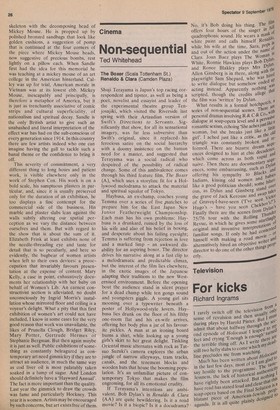Art
Beleaguered
John McEwen
Last year the Arts Council mounted the first in a promised series of shows devoted to an annual display of contemporary British art. The inaugural 'Hayward Annual' was in two parts; it featured on the whole the most established middle-aged English artists and attracted a good attendance and considerable publicity. It was an undeniable and a controversial success. Controversy, needless to say, raged on all fronts. The public, in the form of Fyfe-Robertson who devoted half-an-hour of peak viewing television time to the exhibition, found much of the work incomprehensible and therefore another example of wasteful public expenditure. The critics said it was unadventurous and doubted the motives of the Arts Council and their selection committee. The selected artists dismissed the critics as a bunch of time-serving opportunists. And bringing up the rear were all the arists who had not been selected and knew, of course, that they should have been. Of this enormous and amorphous group it was the women who felt the most hard done by. Only one woman was included in the show and she, accredited professional artist though she is, did just happen to be the wife of one of the selectors. This made her presence seem all the more token, a gesture reminiscent of many other large and officially backed mixed exhibitions in which you seldom find a better ratio than that of one woman to ten men. The result is the 'Hayward Annual '78' (Hayward Gallery till 8 October), an exhibition chosen by five women with, for a change, a token representation of seven men in an exhibition that includes the work of twenty-three artists. The women, naturally since this is a 'politically' inspired show, wanted to have the work of women only, but to this the Arts Council would not agree.
The show, ironically, is rescued by men, particularly by a stunning bronze sculpture of Michael Sandle's entitled 'A Twentieth Century Memorial'. As its title suggests this is a highly ambitious piece, the precise quality that is so lacking from most of the rest of the show. It is uncompromisingly a public sculpture, a war memorial to the futility of war rather than its glorification. The central feature is a machine gun. It is hand cast to enable it to be larger than life-size, and in the subdued light of its setting it gleams golden and immaculate beyond the wil dest dreams of James Purdey. The gunner, also cast in bronze but not polished to a glimmering finish, is a skeleton with the decomposing head of Mickey Mouse. He is propped up by polished bronzed sandbags that look like golden cushions, a suggestion of pomp that is continued at the four corners of the piece where Mickey Mouse heads, now suggestive of precious bombs, rest lightly on a pillow each. When Sandle first had the idea for this memorial he was teaching at a mickey mouse of an art college in the American hinterland. Calley was up for trial, American morale in Vietnam was at its lowest ebb. Mickey Mouse, inescapably and principally, is therefore a metaphor of America, but it is just as trenchantly associative of comic strips and cultural superficiality, of nationalism and spiritual decay. Sandie is the only British artist to give such an unabashed and literal interpretation of the effect war has had on the sub-conscious of every generation since 1914. In this country there are few artists indeed who one can imagine having the gall to tackle such a banal theme or the confidence to bring it off.
This severity of committment, a very different thing to long hours and patient work, is visible elsewhere only in the work of Stephen Cox. His work is on a bold scale, his sumptuous plasters in particular, and, since it is usually preserved only for the duration of an exhibition, he too displays a fine contempt for the commercial side of the business. His marble and plaster slabs lean against the walls subtly altering our spatial perception as we vary the distance between ourselves and them. But with regard to the show that is about the sum of it. Elizabeth Frink at least exhibits none of the needle-threading eye and taste for detail that is so peculiarly, and here so evidently, the bugbear of women artists when left to their own devices: a preoccupation that invariably favours presentation at the expense of content. Mary Kelly, a case in point, exhaustively documents her relationship with her baby on behalf of Women's Lib. An earnest constructivist section is alleviated, no doubt unconsciously by Ingrid Morris's installation whose mirrored floor and ceiling is a voyeur's delight. What a pity that this first exhibition of women's art could not have included, I know in some cases for the very good reason that work was unavailable, the likes of Prunella Clough, Bridget Riley, Mary Potter, Gertrude Hermes or Stephanie Bergman. But then again maybe it is just as well. Public exhibitions of something as constantly beleagured as contemporary art need gimmickry if they are to attract an audience, in much the same way as cod liver oil is most palatably taken soaked in a lump of sugar. And London should definitely have a 'Hayward Annual'. The fact is more important than the quality. Last year the gimmick to draw the crowds was fame and particularly Hockney. This year it is women. Artists may be encouraged by such concerns, but art exists free of them.



































 Previous page
Previous page